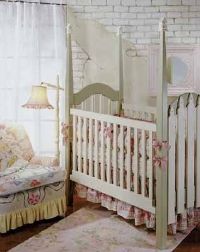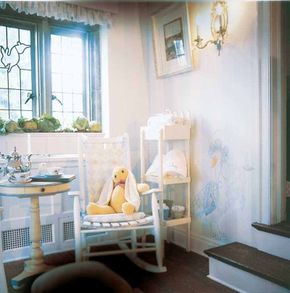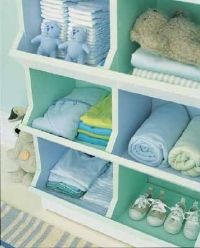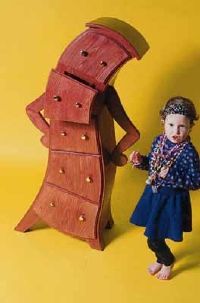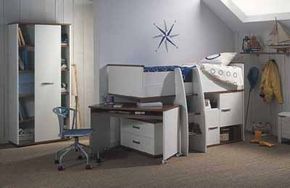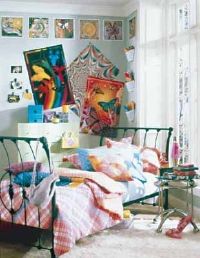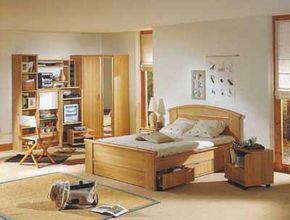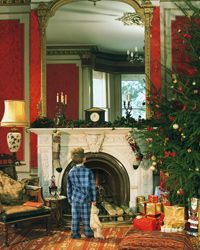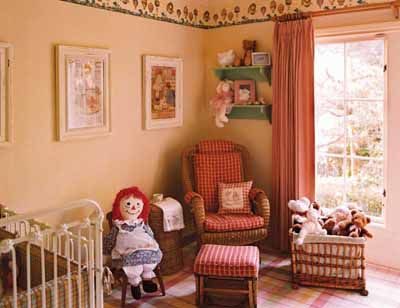Somewhere around age two, children start perceiving colors and details more and their ability to move around and explore is up and running full tilt. At this point, you can indulge yourself and your little one in decorations that feature storybook or cartoon characters, but don't invest a lot unless your budget is ample, as tastes change often at this age. Keep safety in mind, and avoid decorative items with small parts -- anything reachable will be subjected to a taste test!
If your child hasn't left the crib yet, now's probably the time. Youth beds are available in a variety of amusing forms, from sports cars to rocket ships, but their appeal may be limited and their quality is often questionable. If you don't like faddish toddler beds but are worried about putting your child into a full-height twin bed, a practical alternative is to simply put a good-quality twin box spring and mattress on the floor. For the year or two you'll be using it, this interim solution may be easiest. A colorful, washable comforter and bed linens make the look complete.
Toy storage is paramount at this age. Kids accumulate lots of playthings but are easily overwhelmed by even simple cleanup efforts. Make things easier on yourself and on them with lots of low, open storage bins, baskets, and shelves. Choose pieces with smooth surfaces and rounded corners for safety's sake. Under-the-bed storage drawers on wheels are another practical option to help keep less-used items available but not underfoot. A classic toy chest with a flat top can provide ample storage plus an extra play surface. (Just make sure to reinforce hinges and remove lock.) A low chest of drawers is usually sufficient for storing young children's clothes, but you may also want to provide a few low, rounded pegs to make quick work of hanging jackets, overalls, and robes. Hangers are a hassle for youngsters, so plan to hang dressy outfits yourself or provide extra pegs so kids can help.
At this age, children want to play wherever you are, so have some good-looking, easily accessible baskets for collecting toys that tend to end up all over the house. If you have the space, dedicate some low shelves for toys in the family room. If space is too limited, a couple of large handsome baskets stationed in the family room can make short work of cleanup.
In the family room or in their own rooms, children this age will happily play on the floor, so make sure it's still as clean and comfortable as when they were crawling and falling. Wall-to-wall carpeting offers great comfort but can take a beating with craft projects. Consider layering a washable rug or two, or use nonslip rugs on top of easy-to-clean resilient or wood flooring. (Don't use carpeting remnants over carpets or rugs; the rough burlap backing will damage the underlying carpet.) Avoid very dark or very light solid color rugs and carpets that show every spill and stain; opt for midtone hues with some gray, brown, or taupe undertones. For example, choose olive green instead of lime green, royal blue instead of baby blue, teal instead of turquoise blue, burgundy instead of bright red, and mauve or antique rose instead of pink. A strongly patterned rug in midrange jewel tones, including just about any Oriental rug, will hide stains even better and add timeless style.
A child-size table and chairs come into their own for this age-group. Charming affordable sets abound at ready-to- finish furniture shops, and pieces you customize now may be treasured for generations. A small table can become a lamp table later; small chairs work as timeless accessories to hold potted plants on the porch or a colorful stack of towels in the bath. If space or budgets are tight, a round-cornered end table and a footstool or ottoman can stand in as pint-size furniture, as long as the seat and table height are right. Let your child try it out: Make sure there's enough table surface to spread out projects and that the child's feet fully touch the floor.
To complete the room, station a small additional table at bedside to hold a lamp and storybook. A floor lamp is an alternative if space is tight, but be sure it has a heavyweight base to keep it from tipping over during boisterous play, and don't use halogen lights where children can reach them (they are dangerously hot).
Children ages two to five are mentally developed enough to have scary thoughts and feelings, but most still don't have the ability to distinguish real from fantasy information. Even if you are vigilant about protecting them from violent or menacing images on television shows and movies, little ones often find nighttime very frightening. To ensure adequate sleep, close closet doors, put on a small night-light, and provide a security blanket or another "lovie" to cuddle with. These usually count more than all the adorable accessories in the world.
Another scary step in your child's life is starting school. The next page offers decorating ideas for a safe grade-schooler's room.
To get more decorating ideas for your children's rooms, check out:
